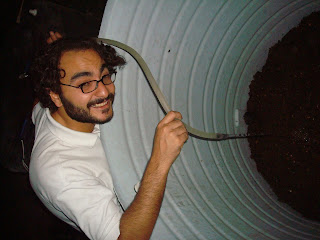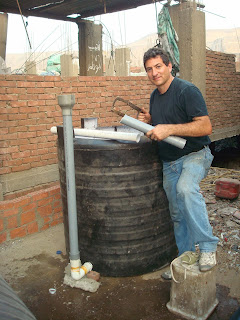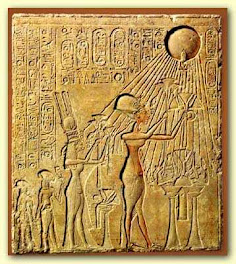Special thanks to Thomas and Nicole Szartowicz for helping to fund the Solar CITIES biogas initiative.)

Photo: Rural systems traditionally use animal manure as the feedstock for biogas digesters, leading people in cities to think they can not take advantage of this simple, clean and effective renewable energy solution.

Photo: As it turns out, the city is the best place for biogas digesters due to an abundance of energy rich kitchen wastes which Dr. Anand Karve of ARTI India estimates produces 400 to 800 times the amount of biogas as animal wastes.
There are more than 20 million small-scale urban biogas digesters in cities in China, and more than 2 million in cities in India. And now, thanks to our Solar CITIES associates and supporters we now have 8 in Egypt, 5 of them in some of the poorest sections of inner city Cairo.
O.K., comparatively speaking 8 is nothing.
But when one is measuring environmental progress at the household level it is hard to beat China and India -- they've had government policies aimed at supporting "appropriate technology" for decades and their cultures contain an entrepreneurial spirit when it comes to enviro-tech that is hard to beat because the household demand in the face of poverty and environmental degradation is huge. A more fair comparison would be with the number of known urban household biodigesters in Germany: 1. It's on our porch. And this is in a country that is one of the kings of biogas production (we should know -- our neighbor in the next town, Imbrahm, has a 1 million Euro facility that processes all the restaurant waste from the surrounding cities to produce millions of Kw of electricity and hot water every year).
Small scale urban bio-digesters are uncommon in the "developed world" if they can be found at all (try to find one in America!). And in developing countries biogas facilities have been largely a rural phenomenon, relying on animal wastes. So 8 small-scale CITY digesters in Egypt appearing within the last 8 months isn't such a bad figure when you consider that Egypt still faces the greatest barrier to the deployment and acceptance of renewable energy systems:
Grossly distorted energy prices due to terribly targeted subsidies.
There, I said it. Energy is too cheap in Egypt and throughout the Middle East/North Africa region. It doesn't matter how much sunshine, wind, biomass or garbage there is in a country if it costs multiples more to turn it into useful energy than it does to simply plug into the grid, the pipe or the bottle.
So the 8 small-scale biodigesters we've built in Egypt, particularly the 5 in the urban core of Cairo, represent an indomitable vision on the part of the early adopters who have decided to integrate these unusual climate change and poverty alleviation solutions on their roofs and into their lifestyles, and we celebrate them!
You can celebrate them too -- by visiting the visionaries struggling to prepare greater Cairo for a greater future. You can see them on a "Solar CITIES Green Technology tour", get to know the families and their stories and even pitch in to Cairo's climate solutions initiative by helping build more renewable energy systems, donating time, expertise, money or materials. Each biogas system costs about 150 dollars for materials. With your support the 8 existing systems can turn into 80, and then 800 ( which we could easily achieve within a little more than two years if we built one per day, which is all it takes) and then 8000 and then 800,000. When we reach a million biogas roofs (and a million solar roofs),we will be well on our way to slowing and then stopping climate change. And because biogas systems eliminate organic waste (turning it into useful clean cooking gas and liquid fertilizer) we will have eliminated the filthy organic garbage problem plaguing Cairo (particularly now that the pigs have been slaughtered due to unfounded Swine Flu fears).
Can you tell me how to get... how to get to Biogas Street?
Photo: Culhane checks with the children of building 72 in Darb Al Ahmar, where Solar CITIES built one of its first hand-made solar hot water systems, to see what they think about the new biogas initiative.
Here's where the 5 inner city systems are located:
Photo 1: The location of the biogas systems shown in Google Earth (download .kmz file here)
Photo 2: The same part of Cairo with street names from Google Maps.
1. Musa's ARTI India style Biogas System
For GPS freaks:
Latitude 30° 1'52.69"N
Longitude 31°16'20.55"E
Altitude: about 12 meters. You'll have to climb some stairs.
For people who still use taxis:
Just under the bridge on El Muqattam Road in Zurayib (aka Shari'a El Furn) on the right before you get to the Zabaleen Recycling School (made famous by Musa and Adham and others in the award winning film "Garbage Dreams").

(Photos: Musa with his rooftop system, T.H. and Watson fellow Kelley Maby helping to build the system).
2. Garbage Association NGO's ARTI India style Biogas System
For GPS freaks:
Latitude: 30° 1'55.70"N
Longitude: 31°16'24.38"E
Altitude: less than 1 meter. It's basically on the ground, really easy to reach. You can also see the first Solar CITIES solar hot water system on the roof of the school opposite.
For people who still use taxis:
Up El Muqattam Road from Musa's also on the right in the garage opposite the famous Zabaleen Recycling School, at the foot of the stairs of the building owned by the Garbage Association NGO, one of the oldest NGO's in the area. See Ishaq, the director, for details.





3. Roh El Shabab (Spirit of Youth) NGO's ARTI India style Biogas System
For GPS freaks:
Latitude: 30° 2'4.44"N
Longitude: 31°16'32.18"E
Altitutude: about 9 meters, up two flights of stairs, on the roof. It is next to a single panel Solar CITIES hot water system that is the first to use pressed recycled plastic bags for the collector box.
For people who still use taxis:
If you can get the driver to continue down El Muqattam road (no easy task, because of prejudice and the fact that the roads are muddy and impassable in the winter) tell him to drop you off on the corner of the road leading up to the St. Samaan Monastery. Both systems are visible from that road, so if you can't find the building (which is tucked away on the next side street on the right), climb up the road to the monastery 100 meters and look down on your right. You will see them.

Photo: Biologist and AUC graduate Ahmed Droubi gets his first taste of loading a biogas digester with bacteria, using cow dung on the first day. After this no further animal manure is needed.

Photo: Culhane puts a 1/2" valve on the gas collector, which we call "the plastic cow's anus", to seal it so that it can start fermenting.

Photo: Culhane, working into the night and filthy as usual, points out the finished systems at Roh El Shabab -- a solar hot water system that uses pressed recycled plastic bags for its collector box and a recycled plastic shampoo barrel as its hot water tank (right) and biogas digester run on organic garbage (left).
4. Hanna Fathy's Solar CITIES home office and Biogas System in Manshiyet Nasser's Zabaleen community
Hanna is a co-founder of Solar CITIES Egypt and works as a renewable energy expert at the Sekem Farm.
For GPS freaks:
Latitude: 30° 2'4.48"N
Longitude: 31°16'22.72"E
Altitude: about 18 meters. You have to climb a flight of stairs from the main street (Shari'a Warshaw) to Hanna's street and then climb 5 flights of stairs in his house to get to the roof. You will also see his three panel home-made Solar HW system. Since this is the home office of Solar CITIES in Cairo you will also be able to enjoy a cup of biogas tea. Hanna speaks fluent English and Arabic and gives Solar CITIES tours as a way of earning extra income to reinvest in his renewable energy experiments.
For people who still use taxis: Forget it. A taxi won't take you to Hanna's house. It is accessible by foot. Get the taxi to drop you off at Kubry Manshiyet Nasser (on Google Maps it is called Kubry AlBageah) and cross El Seka Al Hadied (the railroad track). Climb up Shari'a Al Warsha (known on Google Maps as El Mahgar) past the welder's workshops (where we weld our solar hot water heaters). Look for an imposing garbage strewn staircase leading up between buildings and climb it, then turn left, pass the donkeys on your left and bear right with the road. About 4 iron doors down is Hanna's place. If you get lost go back to Shari'a Al Warsha (El Mahgar) and go down to the welding shop next to the plumbing supply shop. Ask Isa (Arabic for "Jesus") the copper welder who does all Solar CITIES hot water systems how to locate Hanna Fathy. He will help you. There should be a Solar CITIES sign on the door.
Photo: Innoventor Hanna Fathy illuminates his biogas system for nighttime tourists visiting from Canada using a large LED lamp powered by a 9 volt battery, all scavenged from the garbage.

Photo: Innoventors Ayman Fathy and T.H. Culhane run a converted 4 stroke 6.5 HP Engine Electric generator on the biogas produced from yesterday's kitchen garbage.
In this video clip Solar CITIES Egypt director Hanna Fathy, MBA Student and Solar CITIES intern Mike Rimoin and Solar CITIES co-founder T.H. Culhane run a 6.5 HP 3 Kw electric generator for five minutes on biogas. The engine could have run much longer (we think up to half an hour) on a full tank but we didn't have that amount of gas to work with. Ultimately, though, the water vapor in the gas made it very hard to start the engine and we ended up breaking the reciprocal starter spring. (To do: find a way to dry the gas before sending it to the genset. Best would be also to have an automatic rather than pull start.)

Photo: Foreign visitors on the Solar CITIES tour marvel at how much gas a small family can produce each day from just the food waste they would otherwise throw out each day. This tank is filled with 750 liters of biogas, which produces about 2 hours of cooking on a small stove (every 10 cm represents approximately 75 liters), offsetting between 25% and 50% of the household's gas use just from using the garbage.
hannafathy@rochetmail.com
+20.(0)12.1827315
5. Hussain Sulaiman El Farag's Solar CITIES home office and Biogas System in Darb Al Ahmar
Hussain is a co-founder of Solar CITIES Egypt and is a craftsman producing small scale renewable energy systems.
For GPS freaks:
Latitude: 30° 2'27.19"N
Longitude: 31°15'36.57"E
Altitude: about 12 meters. You have to climb a couple of flights of stairs. You will also be rewarded by the sight of Cairo's first space saving solar HW system that hangs off the roof rather than taking space on the roof. Hussain and his brother Hamdi and family have a small metal workshop on the ground floor where they have begun to manufacture hand-made Solar Hot Water systems for sale to villas outside of Cairo. Very entrepreneurial, they also sell the liquid fertilizer from the biogas system to rooftop gardeners and florists for 1 LE per jerry can.
For those who insist on taxis: Take a taxi to Bab Zuela (driver enters at Bab Al Khalq next to the jail off Port Said street on Ahmed Maher street which turns into Darb Al Ahmar street) then ask the driver to continue on Darb Al Ahmar street bearing right as it turns into Darb Al Gadeed at the old mosque. Just before Darb Al Gadeed becomes Al Tabana street turn left and zig zag into Zara El Nawa El Kabeer street. The house has a metal gate and is the second house on your left. Across from it is a garage space where Hussain parks his car. There should be a Solar CITIES sign on the door.

Photo: Ever the entrepreneur, Hussain fills 10 liter jerry cans with the effluent liquid fertilizer his system produces each day and sells them to gardeners for 1 LE (20 cents) each.
Photo: Hussain puts flower planters on top of the digester as weights to increase the pressure pushing the gas down to his stove in his apartment below. Culhane discusses the need to build a cage support to hold the gas collector stable.

Photo: Culhane explains the hybrid solar and biogas systems to a group of visitors from the Aga Khan Trust for Culture.
Photo: One of Hussain's innovations was to mount his solar panels on the roof wall so that he has more space for visitors on the roof.
Photo: Hussain cleverly puts coils of iron wire into the biogas stove to increase its heat output and retention.
Photo: Biogas gas tea being prepared for Solar CITIES tour guests at Hussain's.
hussfarag@yahoo.com
012 422 8748
Systems 6, 7 and 8: Sekem Environmental Science Center and Vocational Training School, Bilbaes (See Previous Post)
Latitude: 30°22'51.90"N
Longitude: 31°39'53.81"E
Hanny Fathy, Solar CITIES "Green Collar Jobs" Coordinator and Trainer, Coptic Christian Community, Cairo Egypt.
hannafathy@rochetmail.com
+20.(0)12.1827315
Mahmoud Dardir, Solar CITIES Associate, Abu Nimrus Environmental Science Center, Cairo Egypt
khamasino2006@yahoo.com
Moustafa Hussain, Solar CITIES Associate, Aga Khan Trust for Culture, Muslim Community, Darb El Ahmar, Cairo Egypt
moustafahussain@yahoo.com
Mustafa Hussein vocational trainer mobil 2010-720-1983
web site http://www.mustafahusein.blogspot.com
Hussein Soliman Farag, Solar CITIES Associate, Solar HW and Biogas System Manufacturer Darb El Ahmar, Cairo Egypt
hussfarag@yahoo.com
012 422 8748





















2 comments:
Loving it guys. Well done. WELL DONE!!
You've made some sterling moves forward in a short space of time.
Not sure about the water tower idea. Can't quite get my head around it but it seems to be getting complicated (valves et al.) and that means more failure points. Been scratching my brain about pressure storage and have just remembered the idea of using inner-tubes - ideally tractor for their size. They're robust, gas-tight, could be ganged for extra storage and can be weighted for pressure. (oh and I guess ubiquitous).
Anyway, I'll leave it there for now while I read your posts again... and head for bed (it's late as usual!)
btw... "doing a Katey Walter" LOL !! ;)
[m]
Thanks for Sharing this good post ! I think these tip are very useful.
Recycling of Waste in Bangalore
Post a Comment